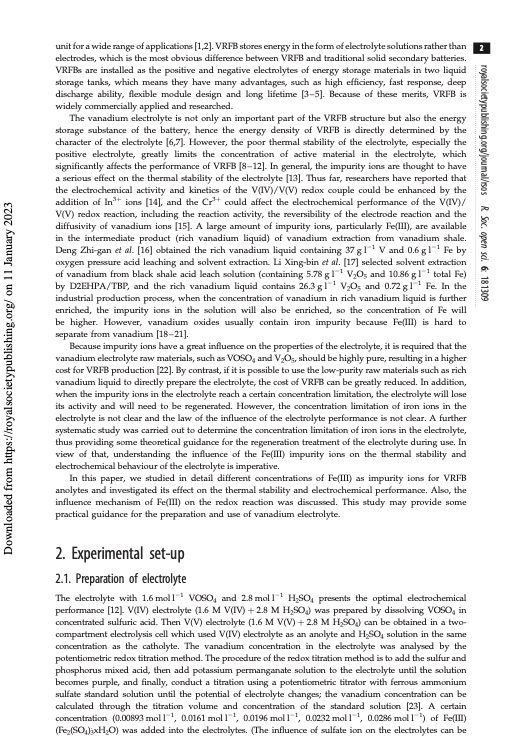
PDF Publication Title:
Text from PDF Page: 002
unit for a wide range of applications [1,2]. VRFB stores energy in the form of electrolyte solutions rather than electrodes, which is the most obvious difference between VRFB and traditional solid secondary batteries. VRFBs are installed as the positive and negative electrolytes of energy storage materials in two liquid storage tanks, which means they have many advantages, such as high efficiency, fast response, deep discharge ability, flexible module design and long lifetime [3–5]. Because of these merits, VRFB is widely commercially applied and researched. The vanadium electrolyte is not only an important part of the VRFB structure but also the energy storage substance of the battery, hence the energy density of VRFB is directly determined by the character of the electrolyte [6,7]. However, the poor thermal stability of the electrolyte, especially the positive electrolyte, greatly limits the concentration of active material in the electrolyte, which significantly affects the performance of VRFB [8–12]. In general, the impurity ions are thought to have a serious effect on the thermal stability of the electrolyte [13]. Thus far, researchers have reported that the electrochemical activity and kinetics of the V(IV)/V(V) redox couple could be enhanced by the addition of In3þ ions [14], and the Cr3þ could affect the electrochemical performance of the V(IV)/ V(V) redox reaction, including the reaction activity, the reversibility of the electrode reaction and the diffusivity of vanadium ions [15]. A large amount of impurity ions, particularly Fe(III), are available in the intermediate product (rich vanadium liquid) of vanadium extraction from vanadium shale. Deng Zhi-gan et al. [16] obtained the rich vanadium liquid containing 37 g l21 V and 0.6 g l21 Fe by oxygen pressure acid leaching and solvent extraction. Li Xing-bin et al. [17] selected solvent extraction of vanadium from black shale acid leach solution (containing 5.78 g l21 V2O5 and 10.86 g l21 total Fe) by D2EHPA/TBP, and the rich vanadium liquid contains 26.3 g l21 V2O5 and 0.72 g l21 Fe. In the industrial production process, when the concentration of vanadium in rich vanadium liquid is further enriched, the impurity ions in the solution will also be enriched, so the concentration of Fe will be higher. However, vanadium oxides usually contain iron impurity because Fe(III) is hard to separate from vanadium [18–21]. Because impurity ions have a great influence on the properties of the electrolyte, it is required that the vanadium electrolyte raw materials, such as VOSO4 and V2O5, should be highly pure, resulting in a higher cost for VRFB production [22]. By contrast, if it is possible to use the low-purity raw materials such as rich vanadium liquid to directly prepare the electrolyte, the cost of VRFB can be greatly reduced. In addition, when the impurity ions in the electrolyte reach a certain concentration limitation, the electrolyte will lose its activity and will need to be regenerated. However, the concentration limitation of iron ions in the electrolyte is not clear and the law of the influence of the electrolyte performance is not clear. A further systematic study was carried out to determine the concentration limitation of iron ions in the electrolyte, thus providing some theoretical guidance for the regeneration treatment of the electrolyte during use. In view of that, understanding the influence of the Fe(III) impurity ions on the thermal stability and electrochemical behaviour of the electrolyte is imperative. In this paper, we studied in detail different concentrations of Fe(III) as impurity ions for VRFB anolytes and investigated its effect on the thermal stability and electrochemical performance. Also, the influence mechanism of Fe(III) on the redox reaction was discussed. This study may provide some practical guidance for the preparation and use of vanadium electrolyte. 2. Experimental set-up 2.1. Preparation of electrolyte The electrolyte with 1.6 mol l21 VOSO4 and 2.8 mol l21 H2SO4 presents the optimal electrochemical performance [12]. V(IV) electrolyte (1.6 M V(IV) þ 2.8 M H2SO4) was prepared by dissolving VOSO4 in concentrated sulfuric acid. Then V(V) electrolyte (1.6 M V(V) þ 2.8 M H2SO4) can be obtained in a two- compartment electrolysis cell which used V(IV) electrolyte as an anolyte and H2SO4 solution in the same concentration as the catholyte. The vanadium concentration in the electrolyte was analysed by the potentiometric redox titration method. The procedure of the redox titration method is to add the sulfur and phosphorus mixed acid, then add potassium permanganate solution to the electrolyte until the solution becomes purple, and finally, conduct a titration using a potentiometric titrator with ferrous ammonium sulfate standard solution until the potential of electrolyte changes; the vanadium concentration can be calculated through the titration volume and concentration of the standard solution [23]. A certain concentration (0.00893moll21, 0.0161moll21, 0.0196moll21, 0.0232moll21, 0.0286moll21) of Fe(III) (Fe2(SO4).3xH2O) was added into the electrolytes. (The influence of sulfate ion on the electrolytes can be 2 royalsocietypublishing.org/journal/rsos R. Soc. open sci. 6: 181309 Downloaded from https://royalsocietypublishing.org/ on 11 January 2023PDF Image | Effect of Fe3 positive electrolyte vanadium redox flow

PDF Search Title:
Effect of Fe3 positive electrolyte vanadium redox flowOriginal File Name Searched:
rsos-181309.pdfDIY PDF Search: Google It | Yahoo | Bing
Salgenx Redox Flow Battery Technology: Salt water flow battery technology with low cost and great energy density that can be used for power storage and thermal storage. Let us de-risk your production using our license. Our aqueous flow battery is less cost than Tesla Megapack and available faster. Redox flow battery. No membrane needed like with Vanadium, or Bromine. Salgenx flow battery
| CONTACT TEL: 608-238-6001 Email: greg@salgenx.com | RSS | AMP |